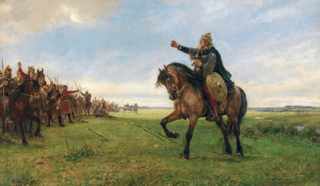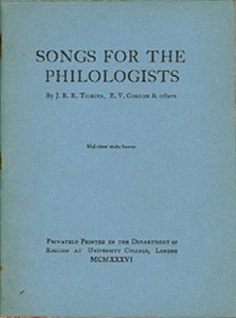
The Canterbury Tales is a collection of twenty-four stories that runs to over 17,000 lines written in Middle English by Geoffrey Chaucer between 1387 and 1400. It is widely regarded as Chaucer's magnum opus. The tales are presented as part of a story-telling contest by a group of pilgrims as they travel together from London to Canterbury to visit the shrine of Saint Thomas Becket at Canterbury Cathedral. The prize for this contest is a free meal at the Tabard Inn at Southwark on their return.
Philology is the study of language in oral and written historical sources; it is the intersection of textual criticism, literary criticism, history, and linguistics with strong ties to etymology. Philology is also defined as the study of literary texts as well as oral and written records, the establishment of their authenticity and their original form, and the determination of their meaning. A person who pursues this kind of study is known as a philologist. In older usage, especially British, philology is more general, covering comparative and historical linguistics.

Smith of Wootton Major, first published in 1967, is a novella by J. R. R. Tolkien. It tells the tale of a Great Cake, baked for the once in twenty-four year Feast of Good Children. The Master Cook, Nokes, hides some trinkets in the cake for the children to find; one is a star he found in an old spice box. A boy, Smith, swallows the star. On his tenth birthday the star appears on his forehead, and he starts to roam the Land of Faery. After twenty-four years the Feast comes around again, and Smith surrenders the star to Alf, the new Master Cook. Alf bakes the star into a new Great Cake for another child to find.

Pearl is a late 14th-century Middle English poem that is considered one of the most important surviving Middle English works. With elements of medieval allegory and dream vision genre, the poem is written in a North-West Midlands variety of Middle English and highly—though not consistently—alliterative; there is a complex system of stanza linking and other stylistic features.
Narrative poetry is a form of poetry that tells a story, often using the voices of both a narrator and characters; the entire story is usually written in metered verse. Narrative poems do not need to rhyme. The poems that make up this genre may be short or long, and the story it relates to may be complex. It is normally dramatic, with various characters. Narrative poems include all epic poetry, and the various types of "lay", most ballads, and some idylls, as well as many poems not falling into a distinct type.

Ancrene Wisse is an anonymous monastic rule for female anchoresses written in the early 13th century.

The Ellesmere Chaucer, or Ellesmere Manuscript of the Canterbury Tales, is an early 15th-century illuminated manuscript of Geoffrey Chaucer's Canterbury Tales, owned by the Huntington Library, in San Marino, California. It is considered one of the most significant copies of the Tales.

Patience Agbabi FRSL is a British poet and performer who emphasizes the spoken word. Although her poetry hits hard in addressing contemporary themes, it often makes use of formal constraints, including traditional poetic forms. She has described herself as "bicultural" and bisexual. Issues of racial and gender identity feature in her poetry. She is celebrated "for paying equal homage to literature and performance" and for work that "moves fluidly and nimbly between cultures, dialects, voices; between page and stage." In 2017, she was elected a Fellow of the Royal Society of Literature.

Hervarar saga ok Heiðreks is a legendary saga from the 13th century combining matter from several older sagas in Germanic heroic legend. It tells of wars between the Goths and the Huns during the 4th century. The final part of the saga, which was likely composed separately from and later than the rest, is a source for Swedish medieval history.

Walter William Skeat, was a British philologist and Anglican deacon. The pre-eminent British philologist of his time, he was instrumental in developing the English language as a higher education subject in the United Kingdom.
Richard Morris, was an English philologist and priest of the Church of England.

Thomas Hoccleve or Occleve was a key figure in 15th-century Middle English literature, significant for promoting Chaucer as "the father of English literature", and as a poet in his own right. His poetry, especially his longest work, the didactic work Regement of Princes, was extremely popular in the fifteenth century, but went largely ignored until the late twentieth century, when it was re-examined by scholars, particularly John Burrow. Today he is most well known for his Series, which includes the earliest autobiographical description of mental illness in English, and for his extensive scribal activity. Three holographs of his poetry have survived, and he also copied literary manuscripts by other writers. As a clerk of the Office of the Privy Seal, he wrote hundreds of documents in French and Latin.

"Namárië" is a poem by J. R. R. Tolkien written in one of his constructed languages, Quenya, and published in The Lord of the Rings. It is subtitled "Galadriel's Lament in Lórien", which in Quenya is Altariello nainië Lóriendessë. The poem appears, too, in a book of musical settings by Donald Swann of songs from Middle-earth, The Road Goes Ever On; the Gregorian plainsong-like melody was hummed to Swann by Tolkien. The poem is the longest Quenya text in The Lord of the Rings and also one of the longest continuous texts in Quenya that Tolkien ever wrote. An English translation is provided in the book.

Songs for the Philologists is a collection of poems by E. V. Gordon and J. R. R. Tolkien as well as traditional songs. It is the rarest and most difficult to find Tolkien-related book. Originally a collection of typescripts compiled by Gordon in 1921–1926 for the students of the University of Leeds, it was given by A. H. Smith of University College London, a former student at Leeds, to a group of students to be printed privately in 1935 or 1936, and printed in 1936 with the impressum "Printed by G. Tillotson, A. H. Smith, B. Pattison and other members of the English Department, University College, London."
Eric Valentine Gordon was a Canadian philologist, known as an editor of medieval Germanic texts and a teacher of medieval Germanic languages at the University of Leeds and the University of Manchester.
Tolkien's legendarium is the body of J. R. R. Tolkien's mythopoeic writing, unpublished in his lifetime, that forms the background to his The Lord of the Rings, and which his son Christopher summarized in his compilation of The Silmarillion and documented in his 12-volume series The History of Middle-earth. The legendarium's origins reach back to 1914, when Tolkien began writing poems and story sketches, drawing maps, and inventing languages and names as a private project to create a unique English mythology. The earliest story drafts are from 1916; he revised and rewrote these for most of his adult life.
This is a list of all published works of the English writer and philologist J. R. R. Tolkien. Tolkien's works were published before and after his death.
The Eneados is a translation into Middle Scots of Virgil's Latin Aeneid, completed by the poet and clergyman Gavin Douglas in 1513.
J. R. R. Tolkien, a fantasy author and professional philologist, drew on the Old English poem Beowulf for multiple aspects of his Middle-earth legendarium, alongside other influences. He used elements such as names, monsters, and the structure of society in a heroic age. He emulated its style, creating an impression of depth and adopting an elegiac tone. Tolkien admired the way that Beowulf, written by a Christian looking back at a pagan past, just as he was, embodied a "large symbolism" without ever becoming allegorical. He worked to echo the symbolism of life's road and individual heroism in The Lord of the Rings.












